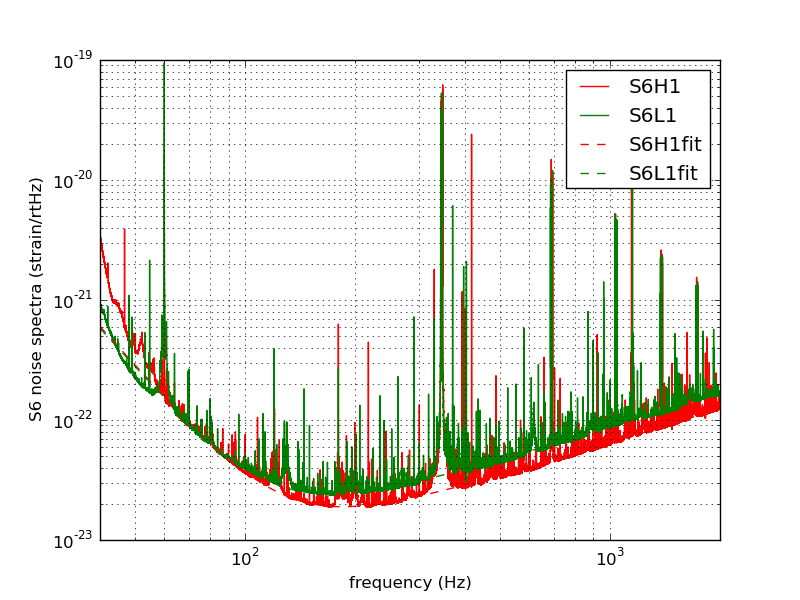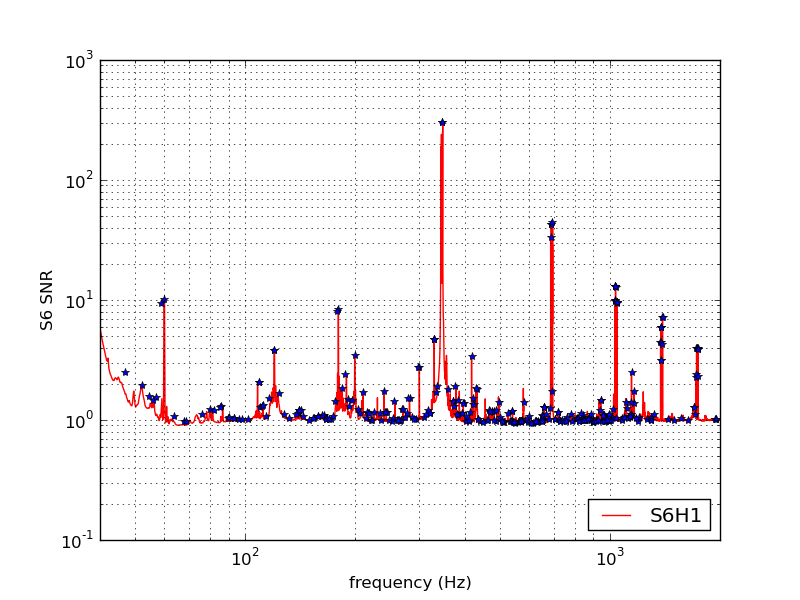S6 Instrumental Lines
One can see many spectral lines in the noise amplitude spectral density (ASD) of the two LIGO detectors during S6:
The plot above shows hi-resolution ASD spectra for both LIGO detectors, averaged over all of S6. You might be able to see a smooth curve that provides an estimate of the "noise floor" under the instrumental lines; it does a poor job of following the real noise floor below 40 Hz. Details of how these spectra are produced are in the Technical Details page.
Impact on astrophysical searches
The excess noise from these instrumental spectral lines will obscure gravitational wave signals in that band, negatively impacting searches for signals of all morphologies (CBC, Burst, CW, stochastic). Most searches for gravitational wave signals "notch out" those bands in one way or another.
Note that continuous waves (CW) from non-spherical spinning neutron stars also appear as (extremely narrow) spectral lines. Their frequency is modulated by the Doppler shift due to the motion of our detectors with respect to the source; this is a small (part in 10^4) effect. We expect the lines to be buried in the noise, and not visible in the noise amplitude spectral densities of the detectors; matched filtering over the full observation time is required to identify potential signals in the data.
Of course, we need to be sure we understand whether the lines visible in the noise spectrum are instrumental in origin, or are extremely strong GWs from astrophysical sources. So, effort is put into understanding the instrumental origin of these lines, and engineering the detectors to keep the line bandwidth as narrow as possible. Some details on the instrumental origin of these lines are given below.
The most prominent peaks
The peaks that are most noticeable to the eye are all believed to be due to known instrumental effects:
- 60 Hz power line harmonics, including "wings" extending +- 2 Hz around 60*n Hz, due to upconversion of low-frequency sesimic noise. These arise due to imperfect electronic shielding, and magnetic coupling to the mirror suspensions.
- Thermally excited mirror suspension "violin modes" at ~329.5 Hz and in the 335-350 Hz range, and harmonics. There is a "forest" of them due to the numerous mirror suspension wires in the LIGO interferometers. These are an unfortunate but inevitable part of the LIGO detector design.
-
Calibration lines inserted by moving the end mirrors. Calibration lines
during S6 were at:
- H1: 46.7, 393.1, and 1144.3 Hz
- L1: 54.7, 396.7, and 1151.5 Hz
In addition to spectral lines whose instrumental origin is identified, there are other narrow "features" in the spectrum whose origin remains unknown. All of these features are rejected by the CW searches conducted by the LSC, because they do not exhibit the expected Doppler modulation, may exhibit very different amplitude and frequency modulation, and/or are not seen with consistent amplitudes in other detectors; we conclude that they are instrumental lines of unknown origin. This is discussed in our S6 Detector Characterization paper on arXiv; our S6 Instrumental Lines paper on arXiv; and our S5 "All-sky search for periodic gravitational waves in the full S5 LIGO data" on arXiv and published.
Instrumental line catalog
The following files contain lists of prominent spectral line frequencies, their signal strength and signal-to-noise ratio, and our identification of their instrumental origins (where known).
- Annotated xlsx spreadsheet, H1_S6lines.xlsx
- Annotated xlsx spreadsheet, L1_S6lines.xlsx
The following plots (S6 H1 and S6 L1) indicate the instrumental lines identified in the above catalog, as blue asterisks:
The next two plots (S6 H1 and S6 L1) "flatten" the spectrum (except at the lowest frequencies) by dividing by the underlying broad-band noise spectrum; the result can be roughly interpreted as the SNR of the lines.
One can see that some lines are marked with multiple blue asterisks; these are indeed multiple, closely-grouped narrow lines (mostly, violin modes of the suspensions of the core optics in the LIGO detectors). There are also many identified lines with low SNR that are not seen as prominent peaks.





